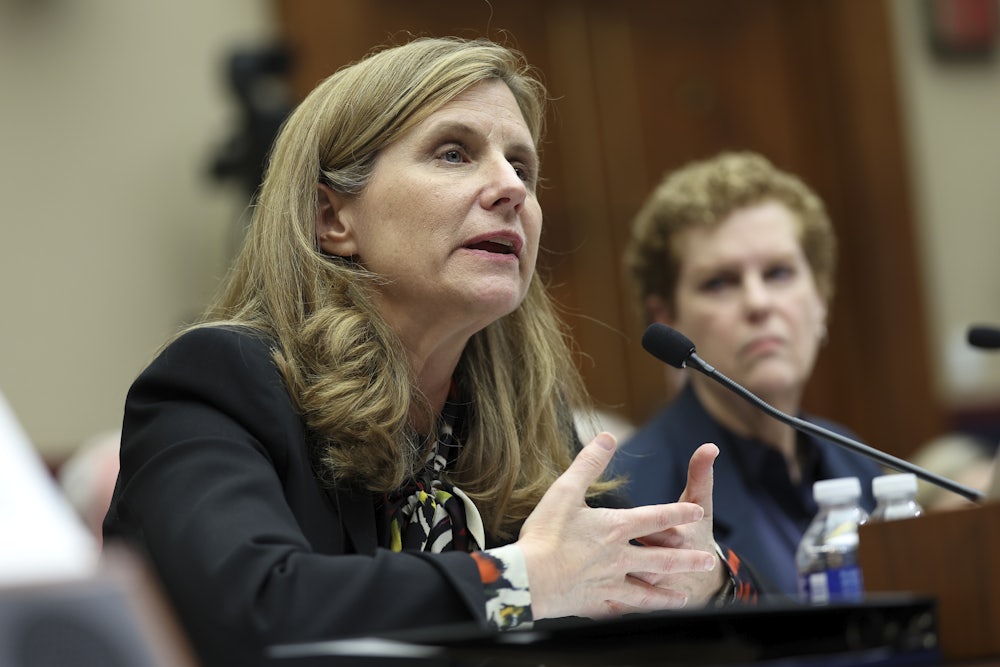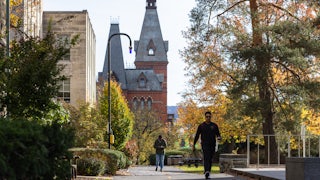The number of minutes I spent over the weekend being angry about the resignation of Liz Magill, who stepped down as president of the University of Pennsylvania Saturday, was precisely zero. Yes, I hate to see conservative donors, in this case Marc Rowan, have this kind of power. Yes, I hate to see Elise Stefanik claim a scalp. And yes, I hate to see the right get to peacock around the place pretending that all the antisemitism in this country emanates from the left—especially since their leading lights are hard-core enablers of hatred toward Jewish people.
But Magill brought her problems upon herself—and not just through her incompetent congressional testimony last week. Her campus has been rife with antisemitism going back nearly a decade. On the same day Magill testified, two Jewish students filed a lawsuit listing more than 100 antisemitic incidents on the campus since 2015 and alleging that the university has done essentially nothing to punish those involved. The complaint makes for horrifying reading, even if only one-third of the claims are true. A large section of it describes a mid-September Palestinian literature event at which several speakers made antisemitic comments. University administrators delivered cavalier-at-best responses to concerned Jewish students, even after someone had broken into Penn’s Hillel House on September 21 and shouted, “Fuck the Jews.”
The temperature was already high long before October 7. And then it took eight days for Magill to issue a statement. Eight days?! What exactly was there to weigh?
Do I believe Magill is an antisemite? Of course not. But she obviously permitted a culture to arise around her where a certain kind of left-wing antisemitism has flourished and gone unpunished.
It’s long past time for university administrators to take antisemitism seriously. For a long time, I admit that I thought this was a fairly limited problem and one that the media, with its insane obsession over a handful of elite schools that they insist represent “higher education,” tended to blow out of proportion. Even the Anti-Defamation League’s own statistics show the biggest spike in antisemitic incidents to be quite recent—they’ve roughly doubled since 2019, to around 3,700, says the ADL.
But now, with the right crowing about this in the wake of last week’s disastrous congressional hearing (see The New York Times’ lead story Sunday), this is not just a campus problem. It’s a potential larger crisis that threatens to unravel liberalism in much the way it did in 1967 and ’68. That, to put it mildly, did not end well.
Before I get to liberalism, let’s talk a bit about the right, where two things are true.
First, antisemitism is far more prevalent on the right than on the left. Always, always keep this in mind in the coming days and weeks as you hear Stefanik and Donald Trump and all the Fox News talking heads carry on about antisemitism being a passion on the left and only on the left.
A recent study in Political Research Quarterly sought to determine degrees of antisemitism on left and right. Researchers Eitan Hersh and Laura Royden asked a series of questions of 3,500 respondents, 2,500 of whom were under 30 (because prior research indicates that antisemitism is higher among young people). They divided them into seven ideological categories—far more than the normal three—because they wanted to get as precise a view as possible of the prevalence of antisemitism among, for example, mainstream liberals and conservatives compared to people further to their left and right.
This was the big takeaway: Antisemitic attitudes were far more prevalent on the right. “The data show,” Hersh and Royden write, “the epicenter of antisemitic attitudes is young adults on the far right.” For example, Hersh and Royden asked respondents if Jews were more loyal to Israel than the United States. The lowest percentages were scored by the “liberal” (17 percent) and “very liberal” (10 percent) groups. The “moderate,” “moderate conservative,” “conservative,” and “very conservative” groups all scored around 40 percent on that question. And the antisemitic sentiment was more prevalent among young rightists than older ones. For example, the percentage of very conservative respondents over 30 who thought Jews have too much power in the U.S. was around 10, while for those under 30, that percentage was around 45.
The second point to make about the right is even more salient. Generally speaking, the antisemites of the left are neither a big part of the Democratic Party nor of the Joe Biden coalition. Many of them, as Jonathan Chait observed in a column last month, actively spurn the Democratic Party. This is the main reason why Biden and Pennsylvania Governor Josh Shapiro, who is Jewish, had no trouble denouncing Magill. The antisemitism that she permitted simply has little to no constituency in the Democratic Party.
On the right, this is emphatically not the case. The antisemites of the right are an absolutely integral part of the Republican–Donald Trump coalition. Trump caters to white supremacists, who adore him. He had dinner with Nick Fuentes and Kanye West, associating with the two men at a time when both were under fire for antisemitic rhetoric. Imagine Biden having dinner with, say, Roger Waters of Pink Floyd, one of the world’s leading antisemites of the left. It would never happen in the first place, but if it did, there would be immediate calls from Democrats, from the Squad to the center, for Biden to step down as the 2024 candidate, if not resign.
But while this is all true of the right, none of it excuses left-wing antisemitism in any way. I will never understand why people can’t hold these five ideas in their minds at the same time:
1. The Israeli occupation of the Palestinian people is deplorable.
2. Benjamin Netanyahu is deplorable.
3. The current Israeli government is deplorable.
4. Antisemitism is deplorable.
5. Anti-Muslim and anti-Arab prejudice is deplorable.
There’s no cognitive dissonance here: All of these statements are consistent with one another. All uphold core liberal values of freedom, self-determination, and opposition to bigotry. This should not be hard.
It should be similarly easy for university presidents to lay before their students a very clear line. Criticize the government of Israel all you want. Call it “apartheid,” if that is your view. That’s a political opinion. Agree with it or not, but it’s fine. It’s a description of reality. Other statements clearly go beyond description to incitement: wishing for Israel not to exist (which can’t happen without the deaths of untold numbers of Jews), celebrating murder and rape, saying that all Jews are legitimate targets of violence. That is not mere political speech. There are gray areas here, certainly, that are hard to adjudicate. But from what I read, no one on campuses is even doing any adjudicating.
If the deplorable Netanyahu drags this war out (and he has every reason to do that, given the fact that he knows that he’s done as prime minister the day it ends), this division on the broad American left could get much, much worse. Here is where history is an important guide: It was at a New Left conference in Chicago on Labor Day weekend in 1967 that the left started to splinter over Israel (the occupation had just begun). That split helped produce the calamitous Democratic convention in 1968 in Chicago, where the older people were in the convention hall cheering Hubert Humphrey and the younger people were out in the streets protesting him (and Mayor Richard Daley). The main things that accomplished, as Michael Kazin wrote here last week, were to elect Richard Nixon and prolong the Vietnam War.
Nixon was seen in his time as a threat to democracy, and he was. But compared to Donald Trump, he was James Madison. Some on the antisemitic left undoubtedly think, sure, let’s get Trump back in there, on the theory of “the worse, the better.” Reality has never really worked like that. In reality, as the antisemitic left is certain to discover if Trump returns to Pennsylvania Avenue, the worse more often leads to the worst.
And presidents of elite universities, who once had the luxury of thinking themselves at a remove from all this, are now front and center. They must act. Penn’s motto, I read over the weekend, is “Leges sine moribus vanae.” Laws without morals are useless. This would be a good time to live up to it.






